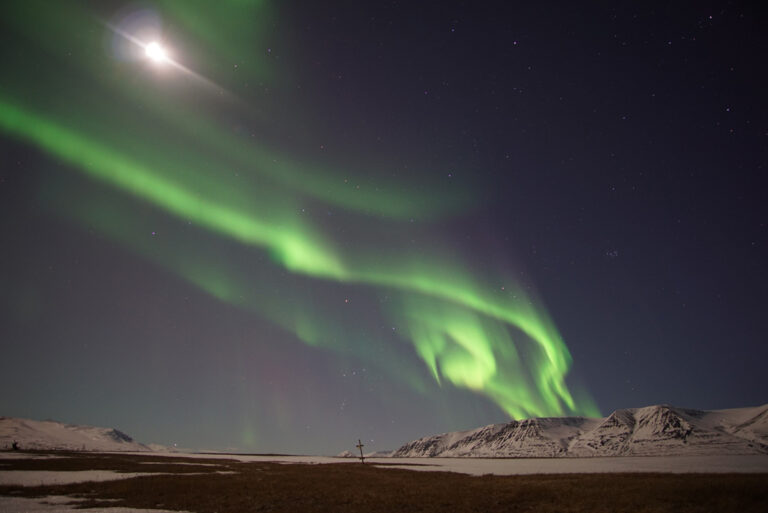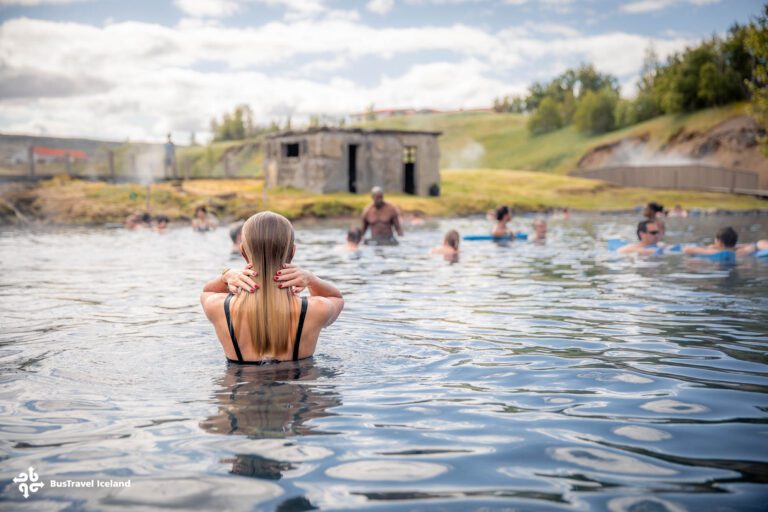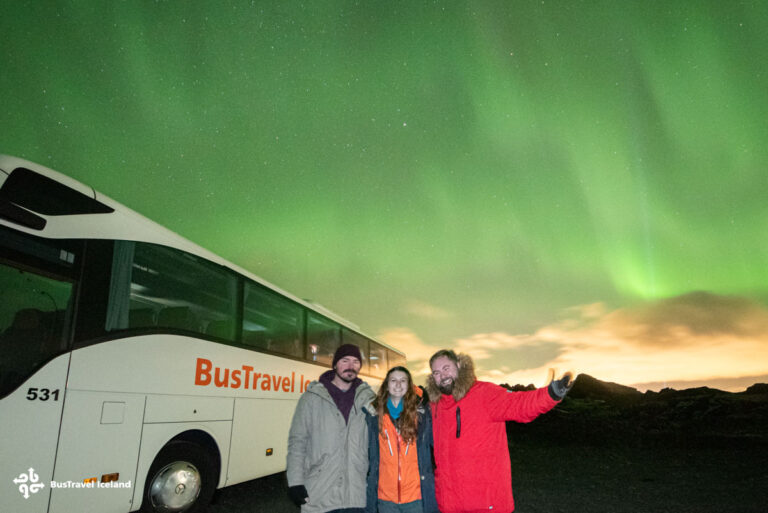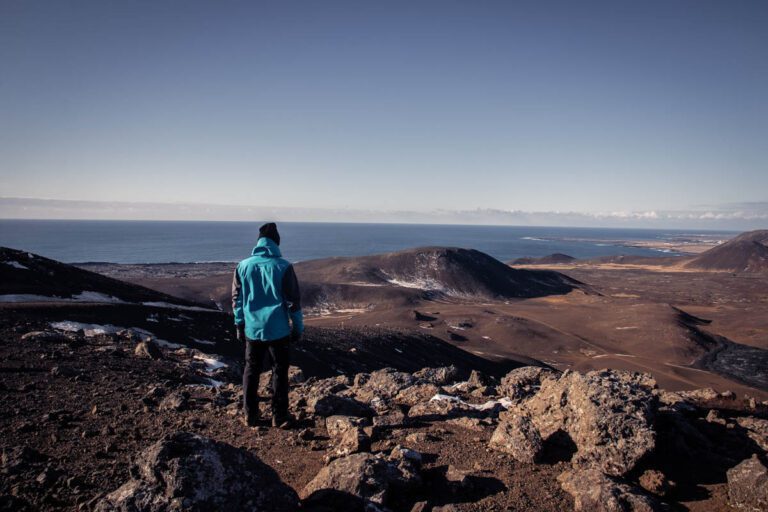Why Iceland Is the Best Place to See the Northern Lights
- Northern Lights
- 28 Nov 2024
Dreaming of the ultimate destination in the world to witness the Northern Lights? Iceland is your answer! Every winter, travelers plan their vacations with the spectacular sight of the aurora borealis in mind, searching for the best places in the world to witness this natural wonder. Among all the destinations, Iceland stands out as a top destination.

Iceland, with its stunning landscapes, clear skies, minimal light pollution and perfect conditions, offers an unparalleled chance to witness the mesmerizing dance of the Northern Lights. Visitors from around the world are drawn to this breathtaking destination for an unforgettable experience beneath its magical glow.
What are the Northern Lights?
The beautiful lights of the aurora, called the Northern Lights (Aurora Borealis)in the north and the Southern Lights (Aurora Australis)in the south, happen mostly near the polar regions because of how Earth’s magnetic field works.
Our planet has a giant magnetic bubble around it, which helps protect us from particles coming from the sun. This magnetic field is strongest near the North and South Poles, so when the sun sends charged particles toward Earth, our magnetic field directs them toward these polar areas.
When these particles from the sun reach our atmosphere, they collide with gasses like oxygen and nitrogen, releasing energy in the form of light. This creates the colorful light displays we know as the aurora. Different gasses produce different colors: oxygen can glow green or red, while nitrogen creates shades of blue or purple.
Since the magnetic field pulls these particles toward the poles, we usually see the aurora only in the far north or south, like in places close to the Arctic or Antarctic Circles. On rare occasions, when there’s a big solar storm or strong solar wind, the lights can appear even farther from the poles, but for the most part, they’re a treat for those in the high latitudes.
Iceland, with its latitude sitting just below the Arctic Circle at around 64° to 66° North, is perfectly positioned for witnessing the Northern Lights. Its high northern location places it right in the prime aurora zone, where the Earth’s magnetic field channels solar particles into the atmosphere, creating vibrant displays of light.

What Are the Best Conditions to See the Northern Lights?
Dark, Clear Nights
The Northern Lights are best viewed during the fall and winter months, typically from late September to early April, when nights are longest and skies are darkest. For an optimal experience, aim to be as far north as possible, ideally near the Arctic Circle in locations like Iceland, Norway, Finland, Sweden, or parts of Canada and Alaska. It’s also essential to be in a remote area away from city lights, as light pollution can dull the vibrant colors of the aurora, making these secluded northern spots ideal for a clear and stunning view of this natural phenomenon.

Clear Skies and Low Cloud Cover
For the best Northern Lights viewing, seek out a clear night with minimal cloud cover, as clouds can completely obscure the aurora from view, even though it occurs in the upper atmosphere. Checking weather forecasts for cloud cover can be especially useful, and some websites and apps provide specialized aurora forecasts, even predicting cloud conditions at popular viewing locations to help you plan the perfect night under the lights.

Solar Activity
The Northern Lights are created when charged particles from the sun collide with Earth’s magnetic field, and the stronger this solar activity, the brighter and more vibrant the aurora. Scientists use the KP Index, a scale for aurora strength, to gauge viewing potential: a KP index of 4 or higher offers a good chance of seeing the lights in northern regions, while a KP index of 6 or more may make them visible even farther south. Solar activity reaches peak periods, known as “solar maximums,” about every 11 years, but intense auroras can also occur during quieter times due to sudden solar flares or coronal mass ejections (CMEs) that send bursts of solar energy toward Earth.

Patience and Perseverance
Even under ideal conditions, the Northern Lights remain unpredictable; on some nights, they appear faint and fleeting, while on others, they burst into vibrant, extended displays. Patience is key, as it often takes several nights of waiting to witness a truly awe-inspiring show. Perseverance means staying committed, returning each night despite the cold, late hours, or the disappointment of missed sightings. This dedication greatly increases your chances of finally experiencing a spectacular display.

What Makes Iceland the Best Country to see the Northern Lights?
Iceland is often considered one of the best places in the world to see the Northern Lights because of its exceptional conditions across several key factors:
Iceland has more dark, clear nights
Iceland’s location near the Arctic Circle means it experiences long, dark winter nights from late September to early April, the peak season for Northern Lights viewing. These extended hours of darkness provide more opportunities to witness the aurora, especially on the darkest winter nights.
Iceland has more days with clear skies and low cloud cover
Iceland’s climate, while famously unpredictable, actually offers more clear nights than many other aurora-viewing locations. Areas such as Thingvellir National Park, the Snaefellsnes Peninsula, and Lake Myvatn often experience clearer skies with less cloud cover, providing better conditions for aurora viewing. The mountainous terrain also creates natural wind barriers that can help clear up clouds, making it possible to find open skies even on a partly cloudy night.

Iceland’s proximity to high solar activity
Iceland is ideally located within the auroral oval, a zone around the polar regions where auroras are most common. Even moderate solar activity can trigger a visible aurora here, as Iceland is positioned right at the edge of the most active area.
For those chasing the lights, this means that Iceland consistently has auroras, even on nights when the solar activity isn’t at its peak, making it a reliable destination.
Iceland’s mild winters make waiting for the Northern Lights more comfortable
Iceland’s winters are surprisingly mild compared to other Northern Lights destinations, thanks to the Gulf Stream, a warm Atlantic ocean current that flows from the Gulf of Mexico across the North Atlantic. This current reaches as far as Iceland, moderating its winter temperatures and keeping them warmer than similarly northern locations.
As a result, visitors in Iceland can enjoy a more comfortable winter experience, making it easier to wait outside for the Northern Lights without facing the intense freezing conditions found in other high-latitude regions.

Iceland’s Short Driving Distances to Avoid Light Pollution
In Iceland, particularly around Reykjavík, the capital region, you only need to drive 20–30 minutes to escape city lights and reach dark skies, a shorter trip than in many parts of Norway, Sweden, or Finland.
With much of Iceland’s population concentrated in urban areas like Reykjavik, large areas of the countryside remain free from light pollution, making it easy for travelers to find clear, open spaces for unobstructed views.
This accessibility allows you to quickly adjust plans if cloud cover shifts or if aurora forecasts improve, ensuring you won’t have to travel far to witness the incredible show in the night sky.
Iceland’s landscapes make the Northern Lights even more enchanting
The aurora is a natural phenomenon that can be unpredictable, requiring time and patience to wait for the perfect moment.
Fortunately, Iceland offers unique ways to make this wait enjoyable—imagine soaking in a geothermal hot spring under the stars, with the aurora dancing overhead. Iceland’s dramatic landscapes enhance the beauty of the Northern Lights, whether they’re swirling over volcanic mountains, mirrored in glacial lagoons, or glowing above vast black sand beaches.
Each location transforms the lights into a truly magical experience, making Iceland one of the most unforgettable places to witness this natural wonder. Here, every moment becomes part of the adventure, whether you’re standing on a volcanic black sand beach or exploring icy landscapes, waiting for the lights to appear.
Iceland offers a diverse range of Northern Lights tours
Iceland offers a wide range of Northern Lights tours, allowing visitors to experience the aurora from both sea and land for a truly unique adventure. On land, you can join guided tours by coach or a mini-bus, super jeep, ATV, or even snowmobile, each taking you into remote areas with dark skies and minimal light pollution, perfect for aurora viewing.
For those who want a different perspective, there are boat tours that take you out into the open ocean, where you can watch the Northern Lights dance above the water, with Iceland’s stunning coastline as a backdrop.
Whether you prefer the thrill of off-road exploration or the peacefulness of the sea, Iceland has Northern Lights tours to match every type of traveler.
If you’re lucky, you might even catch a glimpse of the Northern Lights outside your window on an evening flight to Iceland in winter.
Top 10 Countries in the World to See the Northern Lights
1. Iceland
In Iceland, especially around Reykjavík, you only need a short drive to escape city lights, and with minimal light pollution across the countryside, Iceland offers diverse viewing spots over glaciers, mountains, and black sand beaches. Iceland’s mild winter climate, geothermal hot springs, and variety of aurora tours make it one of the most comfortable and accessible Northern Lights destinations.

2. Norway
Norway, particularly northern areas like Tromsø, sits right within the aurora oval, offering reliable sightings. Norway’s developed aurora tourism includes options like fjord cruises, reindeer sledding, and even views from the Hurtigruten coastal ferry, adding unique touches to the experience.

3. Finland
In Finland, Finnish Lapland provides magical viewing options like glass igloos and aurora cabins, so visitors can watch the lights from a warm and cozy setting. This region also offers classic winter activities like dog sledding, ice fishing, and snowshoeing, making for a full Nordic experience.

4. Sweden
Sweden, especially around Abisko National Park, is known for clear skies and a special “blue hole” microclimate, which often keeps skies clear for aurora viewing. Abisko is a top spot for reliable sightings and offers untouched landscapes that make the experience serene and memorable.

5. Canada
Canada’s vast northern territories, such as the Yukon, Northwest Territories, Alberta, and Manitoba, offer pristine, remote spots free from light pollution. Popular viewing areas like Yellowknife in the Northwest Territories are accessible and have a high success rate for sightings.

6. Alaska, US
In Alaska, the U.S. offers a prime Northern Lights destination in Fairbanks, located directly under the aurora oval. With accessible viewing locations, heated lodges, and thrilling activities like snowmobiling, Fairbanks provides a balanced blend of adventure and comfort.

7. Greenland
Greenland’s high latitude and remote landscapes make it ideal for aurora viewing, with minimal light pollution and striking coastal scenery. Locations near Kangerlussuaq and Nuuk are especially popular, with Greenland’s icy landscapes offering a captivating backdrop for aurora photography.

8. Scotland
Scotland, particularly in its northern regions like the Shetland Islands and Caithness, occasionally experiences the Northern Lights, known as the “Mirrie Dancers.” While sightings are less predictable, Scotland’s rugged coastal beauty and easy accessibility make it a unique Northern Lights destination for UK visitors.

9. Russian
Russia’s northern regions, such as Murmansk and Arkhangelsk, offer prime viewing locations with vast open landscapes. Russia’s Siberian territories also provide incredibly remote viewing opportunities, where the aurora can be seen in pure wilderness, though accessibility is more challenging.

10. Estonia
Finally, Estonia offers a rare but scenic Northern Lights experience along its northern coast, particularly in places like Lahemaa National Park. While sightings here are less frequent than in Arctic countries, Estonia’s natural beauty and easy access make it an interesting choice for aurora viewing in Northern Europe.

The Best Time to See the Northern Lights in Iceland
To have the best chance of seeing the Northern Lights in Iceland, plan your trip between September and March, that’s the time of year when Iceland’s nights are long and dark, creating perfect conditions for the Northern Lights. Around the winter solstice, Iceland has up to 19 hours of darkness, giving you plenty of time to see the aurora. Try to avoid planning your trip during a full moon, as the moonlight can make the aurora harder to see. Arriving five days before a new moon will give you a week of deep darkness, ideal for viewing the Northern Lights.
If possible, visit Iceland during the spring or fall (in September or March), when day and night are equal. At these times, the position of the sun and Earth can make the aurora brighter and stronger. During the equinox, there are 12 hours of daylight and 12 hours of darkness, and solar activity is often high, which powers strong auroras. As we approach the next “solar maximum,” expected in 2024, 2025 and 2026, the sun will be more active, and auroras may become even more intense.
Best Northern Lights Tours in Iceland
Iceland offers a variety of Northern Lights tours that cater to different interests and provide unique ways to experience this natural wonder.
Northern Lights bus tours / coach tours
Bus tours provide a popular and affordable way to experience the Northern Lights in a group setting. Knowledgeable guides take you to well-known viewing spots outside city lights, and many tours even offer a second outing free of charge if the lights don’t appear on the first night, increasing your chances of witnessing the aurora.

Northern Lights small group tours
Small group Northern Lights tours offer a more intimate and personalized way to experience the aurora, perfect for those who prefer a quieter setting with closer interaction with their guide.
These tours typically limit the number of participants, which means guides can give more tailored attention, sharing insights about the Northern Lights and the surrounding landscapes. With fewer people, you’ll have a more relaxed experience, ideal for capturing photos, asking questions, and fully enjoying the magic of Iceland’s night sky.

Northern Lights boat tours
Northern Lights boat tours provide a peaceful and unique way to experience the aurora, with Reykjavik’s coastline as a stunning backdrop. Once out at sea and away from city lights, you’ll have unobstructed views of the night sky, with the calm ocean surface beautifully reflecting the colors of the Northern Lights.

Northern Lights super jeep tours
Super jeep tours are perfect for adventure seekers, taking you deep into Iceland’s rugged landscapes, far from light pollution and crowds. Guided by experts, these powerful 4x4s navigate remote spots like lava fields and mountains, offering a private and thrilling way to experience the Northern Lights in some of Iceland’s most dramatic settings.

Northern Lights photography tours
Specifically designed for photographers and people who enjoy taking photos and want to photograph the Northern Lights, these tours provide the perfect setup to capture stunning shots of the aurora with professional guidance.
Experienced guides share tips and take you to iconic locations, ensuring you leave with incredible photos of the Northern Lights.

Northern Lights snowmobile tours
Snowmobile tours offer an exhilarating combination of glacial adventure and Northern Lights viewing. After an exciting ride across the glacier, you’ll stop in a secluded, snowy spot to watch the aurora in a peaceful and breathtakingly beautiful setting.
Northern Lights private tours
Private and luxury tours provide a personalized and comfortable way to experience the Northern Lights. With a private guide, a cozy vehicle, and added touches like hot drinks or gourmet meals, these tours create an intimate and memorable outing under Iceland’s starry skies.
Tools for Predicting the Northern Lights in Iceland
When planning to see the Northern Lights in Iceland, local resources like the Icelandic Meteorological Office and Iceland’s Aurora Forecast can be invaluable. The Icelandic Meteorological Office’s website provides the KP index, a scale from zero to nine that measures magnetic disturbances; the higher the number, the stronger the aurora activity. Their site also shows cloud cover across Iceland, so you can check if skies will be clear enough to view the lights.
Iceland’s Aurora Forecast, run by locals with deep knowledge of the aurora, offers a similar forecast in a very user-friendly format. While longer-range predictions (such as weeks or months ahead) are less reliable, there are 27-day forecasts available. Thanks to the sun’s rotation, if a strong aurora is observed, there is a higher chance of it reappearing 27 days later, making this type of forecast worth checking as well. Together, these tools can help you maximize your chances of witnessing the Northern Lights.

Why Should You Visit Iceland for the Northern Lights?
Iceland isn’t just about seeing the Northern Lights; it’s about immersing yourself in an adventure you’ll remember forever.
With easy access to remote, dark-sky locations, you’ll have an enjoyable ride to hunt the lights without the need for long, complicated treks. Iceland’s vibrant culture also adds a special touch—imagine warming up after a night of aurora hunting with a cup of Icelandic hot chocolate that many Northern Lights tours offer.
This latitude means that Iceland’s long winter nights and often-clear skies provide the ideal conditions to see the aurora in its full glory.
Visit Iceland for the Northern Lights to experience a natural show unlike anywhere else. When you plan your winter vacation, wanting to see the Northern Lights, aim for a dark, clear night in a remote northern location during peak aurora months. Keep an eye on aurora forecasts for high solar activity, and be ready to wait for the amazing light show!

































